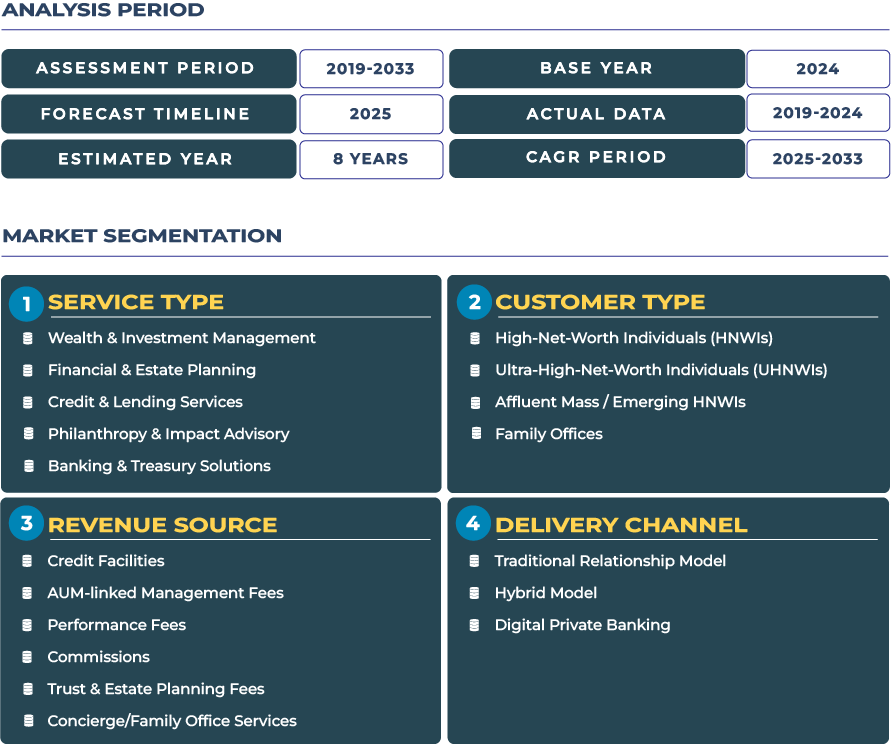Market Outlook: Unpacking the Growth Trajectory for Poland Private Banking Ecosystem to 2033
The market outlook for Poland private banking sector is remarkably optimistic, underscored by the forecasted expansion from USD 9.0 billion in 2025 to USD 21.3 billion in 2033, equating to a robust 11.4% CAGR. This growth is not merely volumetric-it is deeply structural. Poland is witnessing a shifting wealth-map: domestic affluence is rising, regional entrepreneurial exits are generating private-wealth pools, and the digital wealth-infrastructure is increasingly integrated into private banking service delivery.
Note:* The market size refers to the total revenue generated by banks through various services.
Moreover, Poland economy continues to benefit from EU-fund inflows, structural reforms and investment in capital markets development-factors that create tailwinds for growth in the private banking ecosystem. Affluent clients in Poland are no longer satisfied with standard deposit, investment or credit services; they are demanding integrated wealth-journeys that encompass global advisory, digital access, estate planning and impact-driven investment. This shift means private banks must focus on platform transformation, frontal service innovation and deeper client engagement to capture the 11.4% CAGR and position themselves for leadership in Poland private banking landscape.
Drivers of Momentum & Structural Headwinds: What Elevates and What Constrains Poland Private Banking Industry
Poland private banking market benefits from several potent catalysts. The rise of SMEs and the associated generation of new high-net-worth individuals is a prime driver-studies show about 90,000 affluent Poles and this number may triple by 2030. The country’s capital markets are also gaining sophistication, enabling wealth-management firms to offer diversified investment services beyond deposits and loans. Digital inclusion plays a crucial role as well-private banks in Poland are deploying online platforms, mobile onboarding and wealth-tech tools that broaden access and reduce cost-to-serve.
Yet, the market does face structural headwinds. Inflationary pressures remain persistent in Poland, impacting real returns and client portfolios. The ultra-high-net-worth individual (UHNW) segment remains relatively small compared to Western European markets, which limits scale for private banking firms. Regulatory complexity, especially as Polish regulations align with EU transparency and ESG disclosure mandates, increases burden and cost-to-serve. For private banks, navigating market maturity, cost pressures and service-delivery transformation will be critical to sustaining the high projected growth.
Trend-Vectors and Opportunity Spots: Digital Private Banking Apps, ESG Investment Movement and Regional Wealth Alliances in Poland Private Banking Market
In Poland private banking arena, several trends are reshaping how services are delivered and consumed. Digital private banking applications are becoming mainstream, with private banks offering concierge-style access, investment dashboards, payments/treasury integration and mobile advisory. ESG-focused investments are gaining traction among affluent clients, with sustainable portfolios and impact advisory becoming differentiators in the service offering. Regional consolidation is also visible-banks are partnering with fintechs and alternative-asset platforms to scale wealth-services for emerging affluent segments.
For private banks in Poland, distinct opportunity spaces are emerging. One is SME-wealth advisory: targeting entrepreneurs who have built regional success and now require bespoke wealth-management platforms. Another is regional alliances: Polish private banks can deepen cross-border collaboration within CEE (Central and Eastern Europe) to serve mobile wealth and international investment appetite. Finally, digital lending for wealthy clients-tailored credit, leveraged investment lines, treasury solutions-represents a growth vector aligned with digital-first expectations of new affluent generations.
Competitive Landscape: Service Innovation and Market Positioning in Poland Private Banking Sector
The competitive framework of Poland private banking market is evolving quickly. One standout performer, mBank, was named “Best Private Bank: Poland 2025” by an industry awards body, recognised for its growth in assets under management and digital-wealth proposition. Market players are embracing strategies centred on segmentation, digital platform delivery, service integration, and partnerships with fintechs or alternative-asset platforms. Firms that move beyond product distribution to wealth-ecosystem orchestration will carve out leadership in Poland private banking market.







